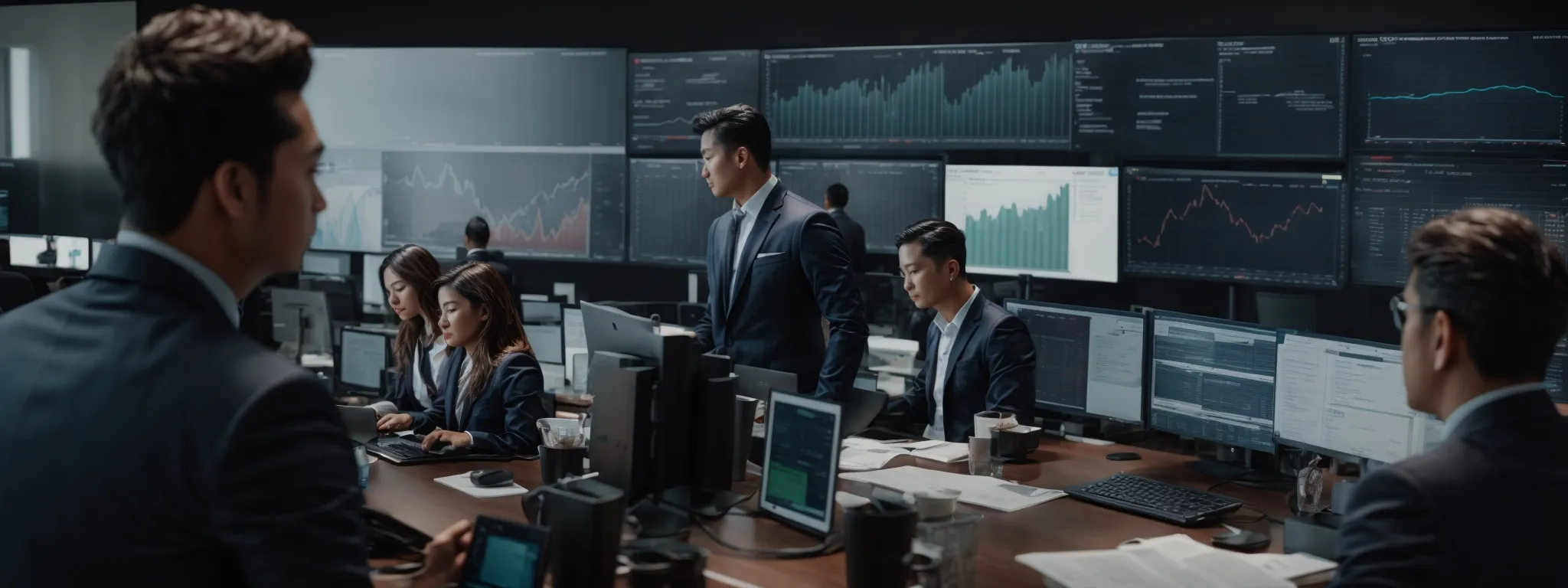Why Optimization Matters for Digital Marketing
The Impact of Optimization on Digital Marketing Success In the dynamic realm of digital marketing, the power of optimization cannot be overstated. Mastery in tweaking and refining […]
The Impact of Optimization on Digital Marketing Success
In the dynamic realm of digital marketing, the power of optimization cannot be overstated.
Mastery in tweaking and refining various facets of an online presence, ranging from search engine visibility to user interactions, significantly bolsters a brand’s digital footprint.
Driven by the aim to maximize ROI, businesses leveraging well-executed optimization strategies often witness a noteworthy elevation in both web traffic and conversion rates.
This synergy of optimization efforts across different online platforms sparks a compounding effect on marketing outcomes, leaving an indelible mark on the success of digital campaigns.
Keep reading to understand how these integral components interplay to amplify your marketing effectiveness.
Key Takeaways
- Effective SEO Strategies Require a Deep Understanding of Keywords and Their Impact on Search Visibility
- Optimized Content That Aligns With User Search Intent Increases Engagement and Search Rankings
- Mobile Optimization and Website Performance Are Crucial for User Experience and SEO
- Data Analytics Is Essential for Tailoring Digital Marketing Strategies to User Behavior and Preferences
- Consistent Content Updates and Authority-Building Are Key for Sustained Digital Marketing Success
Enhancing Visibility With Search Engine Optimization

In the realm of digital marketing, the maxim ‘visibility is viability’ holds paramount importance.
Achieving prominence in search engine results doesn’t merely hinge on happenstance—it’s the result of shrewd SEO strategies that elevate a brand’s digital footprint.
Insights into the role of keywords shed light on the process by which marketers can enhance this visibility; this, in turn, establishes a brand’s presence amidst a sea of digital content.
Content that’s tailored to the pulse of search engine algorithms invariably earns its spot at the summit of the results page, marking a direct correlation between optimization, rankings, and the resultant web traffic surge.
As industry professionals unpack these facets, they provide a framework for comprehending the full spectrum of optimization’s impact on digital marketing success.
Understanding the Role of Keywords in Visibility
The linchpin of any effective SEO strategy is a deep understanding of keywords and their potency in dictating online visibility. These carefully chosen phrases serve as beacons, guiding potential customers through the vastness of the internet to the relevant content that a brand offers.
With precision, marketers curate keywords, building upon them a foundation for content that resonates with both search engines and the human touch. Mastery in this area can transform an anonymous webpage into a bustling hub for an engaged audience:
- Identification of the ideal keywords aligns the content with the user’s search intent.
- Strategic keyword placement accentuates a brand’s message and bolsters search ranking.
- Ongoing keyword analysis ensures the content evolves alongside market trends and consumer behavior.
How Optimized Content Influences Rankings
Optimized content doesn’t just resonate with audiences; it’s a vital tool that allows websites to climb the slippery slope of search engine rankings. By integrating relevant keywords and creating value for the reader, a website’s content can unlock the door to higher visibility and improved search rankings, acting as a magnet for search engine crawlers that prioritize valuable, user-focused information.
By meticulously aligning content with current SEO best practices, digital marketers empower their clients’ websites to commandeer prime real estate on search engine results pages. Effective optimization not just piques the curiosity of search engines, but it transforms passive scrollers into engaged visitors, augmenting both the quantity and quality of web traffic to the site.
The Correlation Between High Rankings and Traffic
High rankings in search engine results invariably trigger an uptick in web traffic, as top positions are often synonymous with credibility and authority in the eyes of a user. As such, a website that appears on the first page of search results is more likely to receive clicks, which can lead to increased visitor engagement and potentially more conversions.
This influx of web traffic resulting from elevated search rankings is not solely about numerical growth—it also enhances the quality of visitors. The match between search criteria and the content of a high-ranking page ensures that the traffic is composed of individuals genuinely interested in the offerings or information presented, thereby boosting the likelihood of achieving the ultimate goal: conversion.
Optimization Drives Better User Experience

The intersection of optimization and user experience is a critical component of digital marketing that demands meticulous attention.
When a brand carefully curates its digital presence to promote ease of use, rapid load times, and universal accessibility, it not only satisfies the technical requirements of search engines but also significantly enhances a customer’s interaction with the website.
By focusing on creating a seamless mobile experience, improving website speed and performance, and optimizing for accessibility and usability, businesses are positioning themselves to cater to the nuanced needs of their audience, which in turn can lead to higher engagement and conversion rates.
Creating a Seamless Mobile Experience
Optimizing for mobile is no longer a luxury; it’s an imperative for brands that wish to provide inclusive experiences to their audience. Mobile devices are a primary portal to the internet for a burgeoning segment of consumers, making mobile optimization an essential aspect of any digital marketing strategy.
Ensuring that a website’s design is responsive and that pages load swiftly on mobile devices goes beyond convenience—it’s about affirming a brand’s commitment to meeting users wherever they choose to engage.
| Criteria | Importance | Impact |
|---|---|---|
| Responsive Design | Crucial | Engagement & Retention |
| Page Load Speed | High | Conversion & User Satisfaction |
| Accessibility | Essential | Brand Perception & Reach |
Addressing these criteria ensures brands can effectively connect with their target audience, reflecting positively on search engine results and, ultimately, the brand’s bottom line: conversion and customer loyalty.
Improving Website Speed and Performance
Enhancing website speed and performance is not solely a technical endeavor; it’s a strategic move that directly influences a user’s perception of a brand. Sites that load quickly satisfy the immediate gratification that users seek online, thereby reducing bounce rates and fostering a positive digital experience.
This relentless pursuit of speed goes hand-in-hand with reliable performance, ensuring that every page a visitor navigates to functions flawlessly: a critical factor in maintaining user engagement and encouraging deeper exploration of a website’s content.
| Load Time | User Impact | Business Impact |
|---|---|---|
| Under 3 Seconds | Increased User Satisfaction | Higher Conversion Potential |
| Over 3 Seconds | Potential Loss of Interest | Risk of Elevated Bounce Rates |
Optimizing for Accessibility and Usability
Ensuring a website is accessible and usable is not just an ethical obligation for businesses; it also strengthens the site’s optimization for a wider array of users, including those with disabilities. By implementing practices such as alternative text for images, keyboard navigation, and transcripts for video content, companies demonstrate a commitment to inclusivity while tapping into an often-overlooked demographic of consumers.
| Feature | Accessibility Benefit | Usability Enhancement |
|---|---|---|
| Alt Text for Images | Helps visually impaired users | Clarifies image context |
| Keyboard Navigation | Supports those with motor impairments | Facilitates device-agnostic browsing |
| Video Transcripts | Assists hearing-impaired users | Offers content consumption flexibility |
Moreover, usability improvements have a direct impact on a site’s success by scaling the user experience across varying devices and browsers. Prioritizing straightforward navigation and easily digestible content structures optimizes user interactions, leading to longer site visits and fostering an environment where engagement can flourish.
Conversion Rate Optimization for Higher ROI

The thrust of any digital marketing endeavor lies in its capacity to turn casual browsers into loyal customers, an evolution that hinges on optimizing conversion rates for a heightened return on investment.
As specialists dissect the complexities of various online pathways, they acknowledge the essence of refining sales funnel efficiency—a meticulous process that plays a pivotal role in cultivating a brand’s financial success.
Critical to this metamorphosis are strategies including A/B testing, which systematically enhances the probability of conversion, and the deployment of personalization techniques designed to forge stronger connections with individuals.
Together, these methodologies are instrumental in transforming the digital sphere into a conducive environment for sustainable growth and customer acquisition.
Analyzing and Improving Sales Funnel Efficiency
Analyzing sales funnel efficiency involves a comprehensive review of a customer’s journey from the first point of contact to the ultimate transaction. Digital marketing experts scrutinize this pathway, leveraging LinkGraph’s Tools to identify bottlenecks that may be impeding conversion rates.
Once impediments are uncovered, the next step is systematic refinement, where SearchAtlas by LinkGraph becomes invaluable. The platform’s insights permit a recalibration of marketing tactics, ensuring that each stage of the funnel is optimized for maximum conversion potential.
A/B Testing: Optimization for Better Conversions
In the quest to maximize the efficacy of digital marketing initiatives, A/B testing emerges as a robust optimization strategy. By comparing two variations of a web page or marketing element, this method exposes which version resonates more successfully with the target audience, leading to better conversion rates.
Further refinement through A/B testing is a perpetual process, where even the most incremental improvements can result in significant gains in user engagement and conversion success. As such, LinkGraph’s digital Marketing Suite Stands as an essential ally in interpreting A/B test outcomes and executing data-driven decisions.
- Evaluation of two distinct versions of web content or design to identify the more effective variant.
- Application of A/B testing findings to optimize digital assets and elevate conversion rates.
- Continuous analysis and iteration that results in steady progress toward enhancing user experience and ROI.
Personalization Strategies to Increase Engagement
Deploying personalization strategies in digital marketing campaigns is tantamount to extending a handpicked invitation to each consumer. Through the analysis of customer data and behavior patterns, brands can tailor experiences that resonate on an individual level, dramatically enhancing the likelihood of engagement and fostering a deeper brand connection.
Embracing the power of personalization, LinkGraph and SearchAtlas by LinkGraph offer innovative tools for marketers to deliver relevant content and offers. This precision in targeting not only captivates the attention of consumers but also significantly improves the odds of converting casual browsers into committed buyers, contributing to a higher ROI for digital marketing efforts.
The Role of Data Analytics in Marketing Success

In the digital arena, data analytics stands as the compass that steers marketing strategies towards success.
Harnessing the power of data enables businesses to intricately weave optimization into the fabric of their marketing efforts.
Through the acute interpretation of user behavior, companies pinpoint the most effective target markets, while predictive analytics offer a foresight that shapes marketing strategies with precision.
The symbiotic relationship between rigorous data analysis and strategic decision-making is poised to transform the very nature of digital marketing, equipping professionals with insights to craft campaigns that resonate deeply with their audience and yield measurable success.
Using Data to Drive Optimization Decisions
Data serves as the backbone of digital marketing optimization, providing marketers with the actionable insights needed to refine their strategies. By analyzing performance metrics and user engagement data, marketers are enabled to tailor their approach, aligning more closely with the preferences and behaviors of their target audience.
With the precision of a surgeon, digital marketers use data to dissect and optimize every facet of their campaigns: from keyword selection to content relevance and user experience. This calculated approach to decision making ensures that each component of a marketing campaign is fine-tuned for efficiency and effectiveness:
- Critical analysis of web traffic and user engagement patterns informs content optimization.
- Conversion tracking enables a deeper understanding of the effectiveness of calls-to-action and landing page designs.
- Performance data sheds light on the customer journey, highlighting areas ripe for improvement and increased ROI.
Interpreting User Behavior for Target Marketing
Grasping the nuanced complexities of user behavior is the cornerstone of target marketing within the digital marketing sphere. By interpreting how potential customers interact with various marketing channels, LinkGraph’s Suite of Robust Analytics empowers marketers to develop highly targeted campaigns that speak directly to the interests and needs of their audience.
This granular understanding of consumer behavior, derived from SearchAtlas’s advanced data analytics, allows for the customization of marketing messages that resonate on a personal level, effectively amplifying engagement and paving the way for a more strategic allocation of marketing resources.
The Impact of Predictive Analytics on Strategy
Predictive analytics stands as a lynchpin in crafting effective digital marketing strategies, by implementing sophisticated algorithms and machine learning, businesses can anticipate user behaviors and upcoming trend directions. This forward-looking approach empowers marketers to stay one step ahead, ensuring that strategic initiatives are both proactive and preemptive in nature.
The strategic application of predictive analytics shapes a more informed, data-driven landscape for digital marketing professionals. Within this terrain, campaigns are not just reactive but built upon the foundation of foresight—targeting potential customers with precision and adapting to market shifts before they unfold, thereby securing a competitive edge.
Social Media Optimization for Greater Reach

In a digitally interconnected landscape, the convergence of social media and optimization emerges as a significant driver for enhancing a brand’s online influence.
The potency of social platforms lies in their ubiquity and the diverse audiences they harbor, beckoning marketers to master the art of tailoring content to the unique ethos of each platform.
This intricate dance of customization demands vigilant attention to engagement metrics as a measure of content’s resonance.
Furthermore, riding the wave of emerging social trends can catapult a brand into the limelight, fortifying its growth trajectory.
Through the strategic nurturing of these components, brands can ensure their social media footprints leave deep, impactful impressions.
Tailoring Content for Different Social Platforms
In a marketplace that buzzes with ceaseless online activity, the art of tailoring content for various social platforms becomes an undeniable imperative for digital marketers. Recognizing the distinct ‘personality’ and usage patterns of each platform, from the brevity of Twitter to the visual story-telling of Instagram, enables marketers to create content that feels native and engaging to the users of each social space.
Professionally crafted social media content echoes the language and expectations of the platform’s user base, fostering genuine connections and facilitating a more meaningful dialogue with an audience. LinkGraph’s suite of digital marketing tools equips marketers with the data and insights necessary to fine-tune this content curation process, ensuring that every post is aligned with the platform’s ethos and the brand’s strategic objectives.
The Importance of Engagement Metrics
Engagement Metrics Serve as the vital signs of social media marketing, reflecting the health of a brand’s relationship with its audience. By meticulously tracking interactions such as likes, comments, shares, and click-through rates, marketers gain invaluable insights into their content’s performance and audience preferences.
These metrics illuminate the trajectory of social media campaigns, enabling marketers to pivot or persevere with marketing efforts: a delicate yet crucial balance in the fast-paced world of digital interactions.
- Engagement metrics provide a quantitative measure of how compelling and interactive social media content is to the audience.
- Marketers utilize these insights to optimize future content, driving up engagement and fortifying the brand’s social media presence.
Leveraging Social Media Trends for Brand Growth
Leveraging social media trends is an adept move for brands aiming to boost growth and amplify their digital footprint. Recognizing and adopting the latest trends can position a brand as a leader, fostering an image of relevance and modernity in the eyes of consumers.
Beyond mere adaptation, the strategic insertion of a brand into conversations surrounding these trends can lead to increased visibility, engagement, and ultimately, growth. It is the savvy interplay with the zeitgeist that marks a brand’s trajectory from participant to pacesetter on social media landscapes:
- A keen understanding of evolving trends positions brands at the forefront of social media innovation.
- Authentic engagement with current trends garners heightened consumer attention and brand loyalty.
- Proactive trend adoption facilitates market penetration and audience expansion, contributing to overall brand growth.
The Symbiotic Relationship Between SEO and Content Marketing

In an environment where digital visibility equates to business growth, the vigorous alliance between Search Engine Optimization (SEO) and content marketing becomes critical.
SEO crafts the pathway that leads users to content, while content marketing frames the narrative that captivates and retains their attention.
Masterful content marketing appeases the complexities of search intent, ensuring that content not only aligns with what users seek but also fosters the establishment of authoritative sources within the digital landscape.
Considering the dynamic nature of search algorithms, the continuity of content updates serves as a catalyst for sustained SEO triumph, propelling brands to the zenith of digital marketing success.
Crafting Content That Satisfies Search Intent
Content that resonates with user search intent is the cornerstone of any effective SEO strategy. By crafting content that articulates and addresses the problems, questions, or needs that users express through their search queries, businesses tap directly into the heart of consumer desire, enhancing the relevance and appeal of their digital offerings.
This alignment between content and search intent is not merely coincidental but the result of analytical rigor. Utilizing tools like LinkGraph’s SEO Content Assistant, marketers can fine-tune their material to mirror the specific interests and inquiries of their target audience, establishing the content as both a valuable resource and a beacon, leading to higher engagement and improved search ranking.
Building Authority With Valuable Optimized Content
Valuable Optimized Content is the bedrock upon which digital authority is constructed. By disseminating information that is both relevant and meticulously aligned with SEO best practices, businesses cement their status as thought leaders in their respective industries.
Publishing authoritative content consistently allows companies to build trust with both search engines and their intended audience: a fundamental aspect of a successful digital marketing strategy.
- Content relevance establishes a brand’s expertise and credibility.
- SEO alignment amplifies content visibility, reaching a broader audience.
- Consistent publishing frequency nurtures trust and sustains audience engagement.
The Importance of Consistent Content Updates for SEO Success
In the intricately woven tapestry of digital marketing, the importance of consistent content updates cannot be overstated. These refreshes signal to search engines that a website is not a static entity, fostering improved search rankings through a demonstration of vitality and relevance in an ever-evolving digital space.
Frequent Content Updates offer an ongoing invitation for crawlers to reevaluate a site’s value, ensuring that the latest information reaches the target audience with expedience. This proactive approach to content management solidifies a brand’s presence in the competitive arena of organic search, maintaining a pulse on consumer interest and SEO efficacy.
Conclusion
Optimization plays a crucial role in digital marketing success by enhancing visibility, improving user experience, and driving higher ROI.
Masterful use of keywords, tailored content, and adherence to SEO best practices elevate a brand’s prominence on search engine results pages, leading to increased web traffic and conversions.
Furthermore, diligent efforts to create seamless mobile experiences, improve website speed, and prioritize accessibility underscore the commitment to a compelling user journey, which in turn fosters engagement and loyalty.
Personalized content and strategic use of data analytics allow for more targeted and effective campaigns.
By harnessing the power of A/B testing and personalization, marketers can fine-tune their strategies for better conversions.
Social media optimization, leveraging the nuances of each platform and engaging with trends, extends a brand’s reach and drives growth.
Lastly, the symbiotic relationship between SEO and content marketing ensures that valuable, authoritative content not only satisfies user search intent but also establishes a brand as a credible source in the digital market.
In essence, optimization is the backbone of a robust digital marketing strategy, indispensable for standing out in the crowded digital landscape and achieving sustainable business growth.














































































